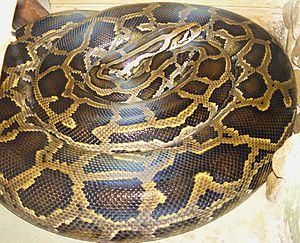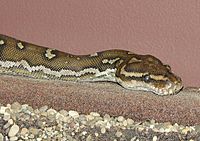Python facts for kids
Quick facts for kids Python |
|
|---|---|
 |
|
| Burmese python (Python bivittatus) | |
| Scientific classification |
|
| Kingdom: | Animalia |
| Phylum: | Chordata |
| Class: | Reptilia |
| Order: | Squamata |
| Suborder: | Serpentes |
| Family: | Pythonidae |
| Genus: | Python Daudin, 1803 |
| Type species | |
| Python molurus Linnaeus, 1758
|
|
| Synonyms | |
|
List
Python Daudin, 1803
Constrictor Wagler, 1830 Enygrus Wagler, 1830 Engyrus Gray, 1831 Enygris Gray, 1842 Heleionomus Gray, 1842 Morelia Gray, 1842 Hortulia Gray, 1842 Asterophis Fitzinger, 1843 Liasis Duméril & Bibron, 1844 Simalia Gray, 1849 Aspidopython Meyer, 1874 Aspidoboa Sauvage, 1884 Hypaspistes Ogilby, 1891 |
|
Python is a genus of constricting snakes in the Pythonidae family native to the tropics and subtropics of the Eastern Hemisphere.
The name python was proposed by François Marie Daudin in 1803 for non-venomous flecked snakes. Currently, between seven and 13 python species are recognized.
Name
The generic name Python was proposed by François Marie Daudin in 1803 for non-venomous snakes with a flecked skin and a long split tongue.
Distribution and habitat
In Africa, pythons are native to the tropics south of the Sahara, but not in the extreme south-western tip of southern Africa (Western Cape) or in Madagascar. In Asia, they occur from Bangladesh, Nepal, India, Pakistan, and Sri Lanka, including the Nicobar Islands, through Myanmar, east to Indochina, southern China, Hong Kong and Hainan, as well as in the Malayan region of Indonesia and the Philippines.
Invasive species
Some suggest that P. bivittatus and P. sebae have the potential to be problematic invasive species in South Florida. In early 2016, a culling operation yielded 106 pythons. Everglades National Park officials suggested that "thousands" may live within the park, and that the species has been breeding there for some years. More recent data suggest that these pythons would not withstand winter climates north of Florida.
Uses
Python skin is used to make clothing, such as vests, belts, boots and shoes, or fashion accessories such as handbags. It may also be stretched and formed as the sound board of some string musical instruments, such as the erhu spike-fiddle, sanxian and the sanshin lutes. With a high demand of snake skin in the current fashion industry, countries in Africa and Southern Asia partake in the legal and illegal selling of python skin. Providing an extremely low pay for the hunters with an extremely high selling product for the consumers, there is an enormous gap between the beginning and end of the snake skin trade.
As pets
Many Python species, such as P. regius, P. brongersmai, P. bivittatus and M. reticulatus, are popular to keep as pets. They are easy to care for, have a docile temperament and vibrant colors. Some rare mutations have been sold for several thousands of dollars.
Pythons in the pet trade are sourced from the wild, or from captive females that were taken from the wild ('captive-born'), or from parents that themselves were born in a captive setting ('captive-bred'). With proper safety procedures pet pythons are relatively safe to own.
Etymology
The word 'Python' is derived from the Latin word 'pȳthon' and the Greek word 'πύθων', both referring to the "serpent slain, who was fabled to have been called Pythius in commemoration of his victory near Delphi by Apollo according to the myth".
 | Sharif Bey |
 | Hale Woodruff |
 | Richmond Barthé |
 | Purvis Young |



